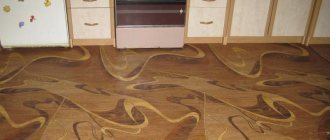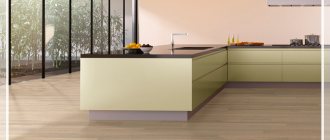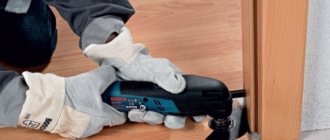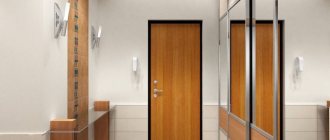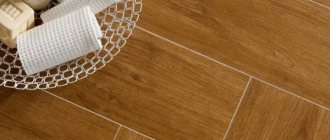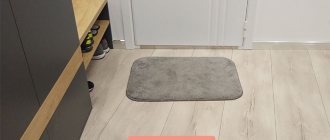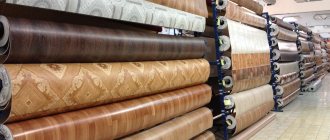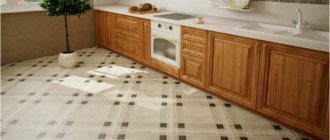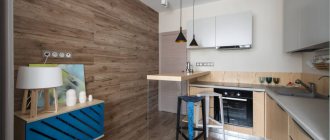Family finances, or rather the lack thereof, constantly force us to look for ways to solve the problem of lack of money. This often results in unexpected ideas. For example, when installing laminate flooring, in order to save money and time, many homeowners try to put slats on the old flooring. At first glance, it seems that this is an attempt to combine incompatible things. What is it really like? In this work we will try to figure out whether it is possible to lay laminate on linoleum using the latter as a substrate.
Laying laminate flooring on linoleum - pros and cons
The arguments in favor of installation are as follows:
- If the linoleum is laid efficiently, evenly and glued, this will help extend the service life of the laminate flooring, since the slats will be protected from moisture coming from below.
- By maintaining two coating options, noise and heat insulation increases, especially if thick coating options are selected.
- The installation of the laminate will take place in relatively clean conditions, without dust and construction debris.
Arguments against double sex:
- If the linoleum has been sitting for a long time before, it is most likely that it will soon begin to deteriorate. Therefore, it is recommended to lay lamellas only on high-quality linoleum.
- When using linoleum instead of a laminate backing, at least 5 mm of the room's height is removed. This must be taken into account if you want to lay a double floor in a room with low ceilings.
- Due to poor-quality installation of linoleum, a “swamp effect” may appear when the floor bends under weight.
- Not all locking systems can withstand the deflection of slats on a soft surface, which is why they soon collapse.
Reviews
Many interesting details can be gleaned from reading user reviews.
Nikita, Moscow:
“The renovation was designed for a small budget. I consulted and decided to save money on removing linoleum. I installed it myself 2 years ago. The floor is fairly level, but not perfect. Therefore, I purchased polyethylene foam for the laminate as a backing. A year and a half has passed, there are no defects or deformations, no rattles when moving.”
Victor, Kaliningrad:
“Much depends on the initial condition of the floor. We laid the laminate according to all the rules, with a backing, on linoleum. After a few months, we noticed deformation in the joint area. I started checking the floor level and found there was a big difference. I shouldn’t have hoped that the substrate and linoleum would level it.”
Many people lay laminate directly on linoleum, and they are satisfied with the result
Evgenia, Kazan:
“They decided to revive the condition of the floor with laminate. Before this, a thorough renovation was done, with a screed. Therefore, they did not remove the linoleum. No problems have arisen in 2 years. I take care of the coating according to all the rules, I don’t moisturize it too much. I clean with a soft mop.”
Rustem, Orel:
“I didn’t bother removing the linoleum. I invested minimally and did everything myself. The laminate was laid on isolon. We've been using it for a year now, no complaints. I advise you not to look for unnecessary problems.”
Svetlana, Krasnodar:
“They left old linoleum on the floor. The floor was previously leveled to almost perfect condition. Therefore, we decided not to take the substrate. After 5-6 months the coating began to creak. They called a repairman and said that the waterproofing was insufficient. Linoleum cannot completely replace the substrate.”
Remember that linoleum cannot replace the substrate in all cases
Do I need to remove old linoleum before laying laminate?
- It is allowed to leave the existing flooring if it was initially laid on a flat base , is not swollen, has no holes, dents or “hills” (and in the existing ones the difference in differences does not exceed 3 mm).
- Sometimes leaving linoleum simply necessary . For example, when it is firmly glued to the floor , and its dismantling will lead to damage to the base of the floor, which will be expensive and time-consuming to repair.
- absolutely necessary to dismantle the linoleum if it has been lying there for many years, has become dilapidated , damp, soft, moldy, or has tears (even small ones).
Preparatory work
When laying lamellas on an old coating, preparatory work is kept to a minimum. Step by step, the entire preparation process is as follows:
- All unnecessary things are removed from the linoleum: furniture and baseboards;
- the surface condition is analyzed. During the inspection, the following are revealed: differences in height; the magnitude of the slope; condition of the material: are there any swelling, cuts, holes; surface humidity level;
- linoleum is vacuumed and then washed.
You can check how smooth the surface is using a level or rule. The tool is placed on the floor and moved along it. All obstacles are measured. If the height difference exceeds 2 mm, the linoleum is removed and the screed is leveled using self-leveling mixtures (there are no other technologies other than refilling the screed). But in this case, according to the editors, it is better to lay under the laminate not old linoleum, but a classic substrate - its behavior is predictable.
The slope can be checked using a rule and a level, or by pulling threads (cord, fishing line) diagonally, and then, using a level and a construction square, measure the slope. The situation is the same here: if the standards are exceeded, the base of the floor (screed) is leveled.
Cuts, cracks, holes are repaired. You can do this in several ways:
- at the cut, the edges are glued to the screed or double-sided tape applied to the back of the floor covering;
- holes and large gaps are cold or hot welded. To do this, damaged pieces of linoleum are cut out, and a patch of the same shape is put in their place, after which the connecting seam is filled with a special mixture. Vinyl, under the influence of cold welding, goes into a semi-liquid state for a short time, after which it polymerizes. The result is an even, strong and durable seam. During hot welding, the seams are brought into a plastic state by heating devices.
The bulges (waves) are cut along the crest and then stretched. The edges of the cuts are glued to the floor screed with polymer glue (when using adhesive tape there is a high probability of re-swelling).
A plastic film with an area of 1 m2 will help to check the surface moisture. It is glued to the floor with tape around the entire perimeter. After a day, the film is removed. If the surface of the linoleum or film is wet to the touch, ventilate the room until, after removing the film, everything is dry.
Important: many experts recommend gluing linoleum completely to the base of the floor, which, in the opinion of the editors of StroyGuru.com, is not entirely correct for several reasons:
- the costs of gluing linoleum to the floor and laying the underlay are almost identical. In this situation, preference should be given to a naturally new substrate;
- the functional role of the glue is unclear, i.e. there is no clear explanation of why this is being done;
- no one thinks about the day when the glued linoleum will have to be removed.
And the main argument is in the reviews of apartment owners, among whom no one glued linoleum to a concrete screed.
Features of laying laminate on old linoleum
Laminate is a material consisting of several layers, so its installation has its own characteristics:
- lamellas can only be laid on a flat base (differences of no more than 3 mm are permissible);
- the base must be completely dry and not allow moisture to pass through;
- It is allowed to lay it using the “floating” and glue method, but it is better to choose the use of special locking systems on top of linoleum.
What you need to know before installation
If you nevertheless decide to lay laminate flooring on linoleum, it is recommended that you familiarize yourself with some of the nuances:
- age of original coverage;
- curing period of laminate coating.
Age and quality of linoleum
When deciding whether to keep the old coating or not, pay attention to the following points:
- Presence of damage to the coating . If there are small holes, they can be sealed with the same linoleum. The main thing is that it sticks firmly to the concrete base.
- If the linoleum is too old , has begun to rot or crumble, you definitely cannot leave it. Such a floor must be dismantled.
- If there are gaps in the concrete base, the linoleum must be torn off and all gaps leveled.
- to allow dampness or moisture under the linoleum. This coating cannot be saved, so the best solution would be to dismantle it.
Duration of laminate
Immediately after purchase, laminate cannot be laid over linoleum. The slats need to be laid out in several rows and allowed to rest for several days, or better yet, a week. Only after this can you begin installation.
Where to start restoration?
To begin with, I would like to say a few words about the restoration of parquet flooring. The first thing you need to start with is assessing the condition of the parquet and identifying its main problems. Here it is necessary to clearly determine by what percentage the parquet is damaged: if it is within 50%, then it still makes sense to restore it. In most cases it is cheaper and faster.
First you need to restore the old parquet
Restoration of a parquet base usually takes place in several stages. First, the parquet is tested for strength. Old planks should not dangle. If such a phenomenon is observed, then it is necessary to secure them by gluing or nailing. You will also have to fill all the cracks and crevices, and treat possible insects such as bark beetles, just in case.
If the parquet creaks, then it is important to get rid of the annoying squeak. After this, you can try to peel off the coating and varnish it
But more often than not, people don’t want to do restoration. It’s easier to cover the old coating and update it by covering it with new material. And in this case, you can use laminate.
Laminate in packages
For which rooms is this installation suitable?
The best choice would be a living room, bedroom or hallway. It is better to avoid laying laminate flooring on linoleum in rooms with high humidity - usually the bathroom and kitchen. In these rooms, the coating suffers not only from high humidity, but also from sudden temperature changes.
If you still had to lay a double floor in such rooms, it is recommended to use a waterproofing layer - double polyethylene is suitable for this.
Flaws
The disadvantages of using linoleum as a base for laminate include:
- in old apartments, linoleum covering can behave unpredictably (in new buildings there is no such problem). Over time, swelling, waves, and other deformations may appear on the surface of the coating, which leads to breakage of the lamella locks;
- If water gets under linoleum covered with laminate, its evaporation occurs very slowly. On the one hand, this is good in terms of preserving the boards, but at the same time, pockets of rot begin to appear in the felt insulation of the laminate, mold appears, and fungus develops. As a result, the entire floor covering has to be replaced;
- According to reviews from craftsmen, some types of linoleum quickly lose their original properties under the laminate. The vinyl layer dries out, becomes cracked and breaks, which, again, leads to the need to replace the base under the laminate.
Laminate flooring can be laid on top of linoleum if the following conditions are met:
- the thickness of the laminate lamellas should not less than 8 mm , it is desirable that they be even thicker;
- old material , on the contrary, not be high - ideally no higher than 3 mm;
- the old coating must be tightly attached to the concrete base without gaps, holes or other defects.
It is recommended to choose a higher-class laminate - they will last longer and there will be fewer problems with operation.
Adhesive installation of laminate involves attaching the lamellas directly to the base with glue. In this case, each part is attached separately. But “floating” installation involves fastening the lamellas between each other using special locks. In this case, dismantling the floor is much easier - you don’t have to tear off the slats and damage them.
Is it possible to lay laminate flooring on an uneven floor?
Before you start laying laminate flooring on old linoleum, you need to decide whether the linoleum is laid on a flat surface. If the base is uneven, new material cannot be laid on top. It will not be possible to level the base with a substrate, even the thickest one - the situation will only get worse. Due to such irregularities, locks often break and creaks appear.
If there are strong differences, it is better to refuse to use linoleum instead of a laminate substrate, otherwise the new coating will not last long.
What if you need to insulate?
There will be difficulties with this, since the heated floor system must be placed on a concrete base; it cannot be placed between the laminate and old linoleum. That is, the linoleum needs to be removed, and then you can do without it.
If you want a multi-layer cake, then put linoleum on a warm floor, a backing on top, and then the laminate itself.
If it is important to insulate the room, but not disassemble the floor covering, then it is best to use a foil backing that will not let heat out of the room and let cold in.
Underlay for laminate on top of linoleum
The underlay is needed to protect against moisture, improve heat and sound insulation, and is placed on top of the linoleum before laying the laminate.
The following types of substrate are best suited for laminate:
- Cork . Made from durable natural material, they protect against fungi and unnecessary sounds. Ideal for rooms where sound absorption is required.
- Polypropylene . Lightweight and soft artificial material. He is not afraid of high humidity. Such substrates will help hide the defects of the base.
- Expanded polystyrene . The main characteristics of the substrate are protection from moisture and heat retention. In addition, polystyrene foam substrates can withstand high loads.
- Conifers . Pressed substrates are available in the form of tiles.
- Foil . It is used in cases where the main task is thermal insulation.
- Polyethylene . A thin layer of canvas, ideal for laying on top of linoleum.
Laying laminate flooring on linoleum - step-by-step instructions
Preparing the base
First you need to remove the existing defects of the base.
- Bubbles . Glue is drawn into the syringe, the bubble is pierced with it and glue is injected under it. Gently press the base with your hand and let it dry completely.
- Cracks . They are filled with silicone-based sealant.
- Holes . To eliminate them, select a patch that is suitable in material and size. Choose a size such that the patch completely covers the defects. The fragment is glued and then processed by cold welding.
The room itself also needs to be prepared for installation.
- The air temperature should be at 18-24°C .
- humidity is within 40-70% .
- The base temperature should not exceed 27°C. The heated floor is turned off a few days earlier.
Laminate installation algorithm
- The first row is laid near the wall opposite the door, starting from the farthest corner. Lay it down in a whole strip. The assembled element is moved towards the wall and wedged on three sides to create gaps of 15 mm.
- The second and subsequent strips begin to be laid from the segment remaining from the previous row. This will allow you to lay the lamellas “staggered”. The finished strip is inserted into the lock of the previous strip and smoothly falls down.
- When laying the last row, the panel is trimmed if necessary.
More detailed information on installing laminate flooring yourself can be obtained from our article.
Installation of thresholds and skirting boards
- Along the entire length of the opening, holes for dowels are drilled every 10 cm. Drilling is performed in such a way that there is a damping gap between the edges of the lamellas and the threshold.
- Plastic inserts are inserted into the holes.
- Thresholds are installed and secured with self-tapping screws.
Styling tips
When laying laminate on top of linoleum, it is recommended to adhere to the following tips:
- After checking the level of differences, the surface must be inspected for deformations. If possible, eliminate them. If this cannot be done, the old coating must be completely removed.
- Linoleum must be installed throughout the entire room.
- The laminate is laid perpendicular to the window. Then the sun's rays will hide the joints.
- Experienced experts advise using the underlay for any room.
- Laminate flooring must be purchased in advance - it is important to let the material rest.
- Before installation, the surface must be thoroughly cleaned.
Possible mistakes when laying laminate flooring on old linoleum
- When choosing a laminate, you need to take into account its height , since double flooring can lead to difficulties in opening and closing doors.
- There will be much less waste if you buy longer strips.
- It is recommended to secure the first and last row with wedges. This will prevent the laminate from moving around the room.
- To avoid damaging the locks, it is better to connect the slats with a rubber hammer.
- You can cut lamellas only at right angles.
- To minimize waste, a new row begins with the sawn section.
- All defects can be corrected at the end of the work using wedges.
Required Tools
The list of tools used for installing laminate flooring is quite wide.
It includes:
- Ruler, square, tape measure.
- A hammer with a regular or rubber striker.
- A hacksaw with a fine tooth, some prefer a hacksaw for metal.
- Electric circular saw or jigsaw.
- Electric drill.
- Shoemaker's or stationery knife.
These tools are quite widespread and are available to almost every home craftsman.
Specialized devices are also needed, used only when installing laminate flooring.:
- Tamping block. Unlike the usual one, it has a special profile that does not destroy the locking part of the panels.
- Installation wedges. You can cut them yourself, but purchased special wedges have the required thickness, expansion angle and special notches that prevent the wedge from being squeezed out when the load is applied.
- Bracket for laminate flooring. It simplifies the padding of panels located near the wall, for example, in the last row.
- Clamps for laminate. They allow you to carefully and tightly press the panels against each other, eliminating the formation of cracks or gaps.
- Knife for laminate. It looks like a photo cutter, only greatly enlarged. Allows you to cut panels in a perpendicular direction. clean and precise.
IMPORTANT!
You can purchase these tools separately, or buy a set for laying laminate flooring, which includes all the most necessary accessories for installation.
